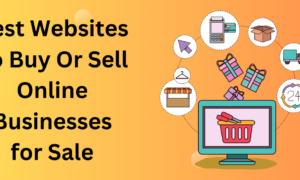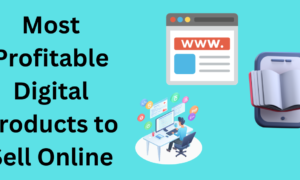Are you ready to embark on a profitable e-commerce journey but unsure where to start? Well, look no further! In the vast and booming world of online business, choosing the right products is like finding the key that unlocks your path to success. Whether you’re a seasoned entrepreneur or just dipping your toes in the digital waters, this blog post is here to guide you through the process of uncovering those hidden gems that will skyrocket your online sales. Get ready to dive into a treasure trove of tips and tricks for finding the best products to sell online—because fortune favors those who choose wisely!
Introduction to E-commerce Success
In today’s fast-paced world, e-commerce has become a popular and lucrative way for businesses to reach and engage with customers. With the ever-growing popularity of online shopping, it is no surprise that more and more entrepreneurs are turning to e-commerce as a means of selling products and services.
However, with the rise in competition in the online marketplace, it is crucial for e-commerce businesses to have a strong understanding of what it takes to achieve success in this industry. In this section, we will introduce you to key concepts and strategies that can help you unlock e-commerce success.
Understanding Your Target Audience
The first step towards e-commerce success is understanding your target audience. Before you even start thinking about which products to sell, it is essential to identify who your ideal customer is. This involves considering factors such as demographics (age, gender, location), interests and preferences (hobbies, lifestyle), and purchasing behaviors (online shopping habits).
Once you have a clear understanding of your target audience, you can tailor your product selection process accordingly. For instance, if your target market consists mainly of young adults interested in fitness and health, products related to these areas would likely be successful.
Identifying Trending Products
Another key aspect of finding the best products to sell online is keeping up with current trends. Researching trending products allows you to capitalize on consumer demand and stay ahead of competitors.
One way to identify trending products is by monitoring social media platforms such as Instagram or TikTok
Understanding Your Target Market
Understanding Your Target Market is an essential step in finding the best products to sell online. Knowing who your customers are and what they want is crucial for e-commerce success. A successful online business understands their target market’s needs, desires, and behaviors to tailor their product offerings and marketing strategies.
The first step in understanding your target market is to conduct thorough market research. This involves gathering data on the demographics, interests, buying habits, and preferences of your potential customers. You can gather this information through surveys, focus groups, or by analyzing online trends and social media conversations related to your niche.
Once you have collected enough data, identify the key characteristics of your target market such as age range, gender, location, income level, education level, and lifestyle. This will help you create a buyer persona – a semi-fictional representation of your ideal customer that includes their interests, pain points, goals, and purchasing behavior.
Next, analyze the collected data to find patterns and insights about your target market’s needs and preferences. This will help you determine what products are in demand within that particular segment of the market. Look for gaps or problems that are not being adequately addressed by existing products so you can offer a unique solution.
It’s also crucial to understand how your target audience shops online. Do they prefer to purchase from established brands or are they more likely to try out new products? Are they price-sensitive or willing to pay a premium for high-quality items? Do they make impulse purchases or do they research extensively
– Conducting Market Research
Market research is a crucial step in the process of finding the best products to sell online. It involves gathering and analyzing information about consumer behavior, market trends, and competition in order to make informed decisions and identify profitable opportunities.
The following are some tips for conducting effective market research to help you unlock e-commerce success:
1. Define Your Target Market: Before you can start researching potential products, it’s important to have a clear understanding of who your target audience is. This will help you tailor your research towards their needs and preferences.
2. Use Online Resources: The internet is a treasure trove of information when it comes to market research. Conducting online surveys or using tools like Google Trends can give you insights into popular products, consumer demographics, and search volume for certain keywords.
3. Analyze Competitor Strategies: Take a look at what your competitors are doing – what products they offer, their pricing strategy, customer reviews – this can help you understand the current market landscape and identify gaps that you can fill with your own offerings.
4. Utilize Social Media: Social media platforms such as Facebook, Twitter, Instagram, etc., provide valuable insights into consumer behavior through comments, likes, shares and hashtags related to specific products or brands. Monitor these channels to gain knowledge about what people are talking about and what they’re looking for.
5. Attend Trade Shows/Exhibitions: Attending trade shows or exhibitions related to your niche allows you to network with suppliers/manufacturers directly and see new
– Identifying Customer Needs and Preferences
Identifying Customer Needs and Preferences is a crucial step in finding the best products to sell online. As an e-commerce business, your success depends on understanding what your target audience wants and needs. By catering to their preferences, you can offer products that are in high demand and increase your chances of generating sales.
Here are some tips for identifying customer needs and preferences to help you choose the right products for your online store:
1. Conduct Market Research: The first step in identifying customer needs and preferences is conducting thorough market research. This involves gathering data on consumer behavior, trends, and popular products in your target market. You can use tools like Google Trends, social media analytics, or conduct surveys to get a better understanding of what people are looking for.
2. Analyze Your Competitors: Another way to identify customer needs and preferences is by analyzing your competitors’ offerings. Look at their top-selling products and determine why they are successful. Pay attention to customer reviews and feedback to see what features or benefits they value most in a product.
3. Use Keyword Research: Keyword research is vital when it comes to identifying customer needs as it allows you to understand what terms people are using when searching for specific products online. Use keyword research tools such as Google Keyword Planner or Ahrefs to find relevant keywords related to your niche.
4. Consider Seasonal Trends: Keeping up with seasonal trends can give you valuable insights into what customers want at different times of the year. For example, if you’re selling clothing
Choosing a Niche or Industry
– Analyzing Trends and Demand
Analyzing the latest trends and understanding consumer demand is crucial in unlocking e-commerce success. By keeping a pulse on the market, you can identify what products are popular and have high demand, allowing you to capitalize on these trends and make informed decisions on which products to sell online. In this section, we will discuss key strategies for analyzing trends and demand to help you find the best products to sell online.
1. Researching Current Market Trends:
The first step in understanding consumer demand is researching current market trends. One effective way to do this is by using Google Trends, an online tool that tracks search query data and displays it in a visually engaging graph. You can enter keywords related to your industry or product idea and see how their popularity has changed over time. This will give you valuable insights into what people are searching for, helping you identify potential product niches with high demand.
2. Utilizing Social Media:
Social media has become an essential platform for businesses looking to stay connected with their customers and understand their preferences. Platforms like Instagram, Facebook, Twitter, and Pinterest can provide valuable information about the latest trends through hashtags or trending topics that users engage with regularly. Additionally, you can also use social media listening tools like Hootsuite or SproutSocial to track mentions of your chosen industry or products to gain further insight into consumers’ needs and desires.
3. Keeping an Eye on Competitors:
Another critical aspect of analyzing trends is keeping an eye on your competitors’ actions in terms of pricing strategies
– Evaluating Competition
Evaluating Competition is a crucial step in finding the best products to sell online. In today’s highly competitive e-commerce market, it is essential to thoroughly assess the existing competition before deciding on a product to sell. Failing to do so can result in investing time and resources into a product that has little potential for success.
To effectively evaluate competition, you need to follow a strategic approach that includes thorough research and analysis. This section will provide you with some tips and strategies for evaluating competition when looking for the best products to sell online.
1. Identify Your Niche:
The first step in evaluating competition is to identify your niche market. Trying to compete with big brands in broad markets can be challenging and expensive, particularly for small businesses or startups. Instead, focus on finding a smaller niche within your industry where there are fewer competitors. By catering specifically to this target audience, you have better chances of standing out and gaining success.
2. Conduct Targeted Keyword Research:
Keyword research plays an essential role in understanding what drives customers towards specific products or services. By conducting targeted keyword research using tools like Google Keyword Planner or SEMrush, you can gain insights into popular search terms related to your chosen niche. This will help you determine how saturated it is with competitors and what opportunities exist for new players.
3. Analyze Competitor Websites:
Visit competitor websites within your niche and analyze their design elements, product images, descriptions, pricing strategy, customer reviews, shipping options, etc., by doing so; you
Identifying Product Opportunities:
One of the key factors for ecommerce success is having a successful product to sell online. However, with millions of products available in the market, choosing the right one can seem like a daunting task. In this section, we will discuss some effective tips for finding the best products to sell online.
1. Research Trends and Demands:
The first step in identifying product opportunities is conducting thorough research on current trends and consumer demands. This can give you insights into what products are currently popular and have high demand in the market. Keep an eye on social media platforms, news websites, and industry reports to stay updated on emerging trends.
2. Explore Niche Markets:
Instead of targeting broad markets, consider focusing on niche markets that are underserved or have less competition. This allows you to cater to specific customer needs and stand out from competitors. Conduct market research to identify untapped niches that align with your interests or expertise.
3. Analyze Your Competitors:
Studying your competitors can provide valuable insights into potential product opportunities. Look at their offerings, pricing strategies, marketing techniques, and customer reviews to understand their strengths and weaknesses. Based on this information, you can find ways to differentiate your product or improve upon existing ones.
4. Take Customer Feedback into Account:
Listening to customer feedback is crucial when it comes to identifying successful products for your ecommerce business. Pay attention to what customers are saying about similar products in terms of features they like or dislike, functionality issues
– Using Keywords and SEO
Using Keywords and SEO are crucial elements for finding the best products to sell online. In today’s competitive e-commerce market, it is important to have a solid understanding of how keywords and SEO work in order to increase visibility and drive traffic to your online store.
Firstly, let’s define what keywords and SEO actually are. Keywords are words or phrases that people use when searching for products on search engines like Google or Amazon. These can be specific product names, descriptions, or even general terms related to your industry. SEO (Search Engine Optimization) is the practice of optimizing your website content in such a way that it ranks higher on search engine results pages (SERPs). This involves using relevant keywords and other techniques to improve your website’s search engine ranking.
So why exactly are keywords and SEO important for finding the best products to sell? Here are three key reasons:
1. Keyword research helps you understand demand: Conducting thorough keyword research allows you to gain insights into what customers are actively searching for in relation to your product niche. By analyzing popular search terms, long-tail keywords (more specific phrases with less competition), and related searches, you can get a better understanding of what consumers want and tailor your product selection accordingly.
2. SEO drives organic traffic: Ranking high on SERPs means more visibility for your online store, which in turn leads to more organic traffic. And when people reach your website through relevant keyword searches, they’re already interested in what you have to offer – making it more likely
– Utilizing Social Media Listening
In today’s digital age, social media has become an integral part of our daily lives. It is not only a way to connect and communicate with others, but it’s also a powerful tool for businesses to understand their target market and gain valuable insights about consumer behavior. This is where the concept of social media listening comes in – utilizing various online platforms to actively monitor and analyze conversations, mentions, and trends related to your brand or industry.
Why is Social Media Listening Important for E-commerce?
In the world of e-commerce, competition can be fierce, and staying ahead of trends is crucial for success. With the ever-changing preferences and behaviors of consumers, it can be challenging for online retailers to stay on top of market demands. That’s where social media listening comes in handy.
By tapping into social media conversations and analyzing keyword usage, tone, sentiment, hashtags, and popular topics related to your niche or products you sell online – e-commerce businesses can gather valuable insights into what their customers want. This information helps them make data-driven decisions about product development or marketing strategies that will resonate with their audience.
Furthermore, social media listening offers an excellent opportunity for e-commerce businesses to engage with potential customers directly. By monitoring relevant hashtags or joining relevant groups/communities on various platforms such as Facebook, Twitter, Instagram or LinkedIn – brands can participate in discussions and answer questions that help establish trust with potential buyers.
How To Effectively Utilize Social Media Listening For E-commerce Success
1) Identify Your Target Audience:
Evaluating Product Viability
Evaluating Product Viability is a crucial step in choosing the best products to sell online. This process involves assessing the potential demand, competition, and profitability of a product before investing time and resources into selling it. By carefully evaluating product viability, you can identify which products have the highest chances of success and focus your efforts on them.
Here are some key factors to consider when evaluating product viability:
1. Market Demand:
The first thing to assess is whether there is a market demand for the product you are considering. Conduct thorough market research to understand if there is a need for this product in the market and how strong that need is. Look at industry reports, search trends, and consumer insights to get an accurate understanding of the demand for your chosen product.
2. Competition Analysis:
While having some competition can be a good sign that there is a market for your product, it’s important to evaluate their strength and strategies before finalizing your decision. Analyze their pricing strategies, customer reviews, marketing tactics, and overall brand presence. This will give you valuable insights into how you can differentiate yourself from competitors or enter the market with unique selling points.
3. Profitability Potential:
Next comes analyzing the profitability potential of your chosen product. Calculate all the costs associated with sourcing, manufacturing, storing, shipping and advertising the product against its retail price to determine if it has enough profit margins for sustainable growth in sales volume.
4. Target Audience Compatibility:
Understanding who will be interested in buying your products plays a
– Considering Profit Margins
Profit margins are a crucial aspect to consider when choosing products to sell online. As an e-commerce business, your main goal is to generate revenue and make profits. But with so many products available in the market, it can be challenging to determine which ones will bring in the most profits for your business.
In simple terms, profit margin is the percentage of profit that you make from each product sold. It is calculated by subtracting the cost of goods sold (COGS) from the selling price and dividing it by the selling price. For example, if you sell a product for $50 and its total cost including manufacturing or purchase costs is $30, then your profit margin would be ($50 – $30)/$50 = 40%.
Now you might wonder why profit margins are important in e-commerce? Well, there are several reasons:
1. Helps You Determine Product Viability: By understanding your profit margins, you can easily determine whether a particular product is worth selling or not. If a product has low-profit margins, it may not be worth your time and effort as it won’t bring in substantial profits for your business.
2. Ensures Sustainable Growth: E-commerce success relies on sustainable growth where your business generates enough revenue to sustain itself. Without considering profit margins, there’s a risk of pricing yourself too low or too high, making it difficult to sustain long-term growth.
3. Allows Room for Discounts and Promotions: Offering discounts and promotions can be an effective marketing strategy in e
– Assessing Shipping and Handling Logistics
When it comes to running a successful e-commerce business, having efficient and effective shipping and handling processes in place is crucial. Without proper logistics in this aspect, you risk losing customers due to delayed or damaged shipments, which can damage your reputation and ultimately affect your sales.
Assessing your shipping and handling logistics involves evaluating every step of the process from picking and packing orders to the delivery of products at the customer’s doorstep. Here are some key factors to consider when assessing your e-commerce shipping and handling:
1) Shipping Costs: The first step in determining if your shipping and handling processes are working efficiently is by evaluating the costs involved. Shipping costs can eat into your profits if they are not carefully managed. Look at different shipping options available and compare prices to see if you can cut down on costs without compromising on quality.
2) Order Fulfillment: This refers to how quickly you can pick, pack, and ship an order after it has been placed by a customer. Prompt order fulfillment is critical in keeping customers satisfied as they expect quick delivery times. Evaluate how long it takes for orders to be processed, packed, and shipped from your warehouse.
3) Packaging Materials: Your packaging plays a vital role in ensuring that products arrive safely to customers without damage. Consider using sturdy materials that provide adequate protection for fragile items while also being lightweight enough not to add additional weight charges.
4) Inventory Management: Efficient inventory management is key in ensuring that you have enough stock available for fulfilling orders promptly without overstock
Supplier Sourcing
Supplier sourcing is a crucial aspect of running a successful e-commerce business. It involves finding and establishing partnerships with reliable suppliers who can provide you with high-quality products at competitive prices. A strong supplier network is the backbone of any e-commerce operation, as it determines the availability, quality, and pricing of your products.
Here are some tips for effective supplier sourcing that will help you find the best products to sell online:
1. Determine your sourcing strategy: Before starting your search for suppliers, it’s important to have a clear understanding of your business goals and target market. This will help you determine what types of products you want to sell and where they would be sourced from. There are various sourcing strategies such as working with manufacturers directly, using dropshipping services or buying from wholesale directories.
2. Research potential suppliers: Once you have identified your preferred sourcing strategy, start researching potential suppliers. You can use online directories like Alibaba or SaleHoo to find overseas manufacturers or trade shows and industry events to connect with local suppliers. Additionally, reach out to other e-commerce businesses or join forums related to your niche to get recommendations for reliable suppliers.
3. Consider their product range and quality: When evaluating potential suppliers, it’s essential to consider the breadth and quality of their product range. Look for suppliers who offer a variety of products in line with your business goals and ensure that their quality meets industry standards. Ask for samples if possible before making any commitments.



























